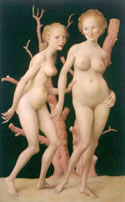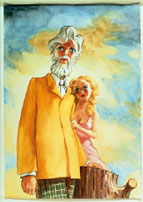
The Disappearance of Adulthood
John Currin at the Whitney Museum
By Maureen Mullarkey
Currin is an accomplished stylist who knows how to cover a canvas. His paintings are full of small seductions. The edges of his forms are everywhere graceful. His handling of drapery and clothing can be delicious. His yellows, glazed over solid brushwork, are particularly toothsome. His compositional eye is a designer's envy. And he is deft and appealing in his handling of still life. Without doubt, Currin offers good reasons to look at his work. But more compelling are the reasons to look away, because the problems with Currin do not lie in his brush. They lie in a deficit of meaning. And in his disdain for his subjects. The over-riding character of this work is a casual nihilism that disdains its audience as well.
 | |  |
| The Pink Tree |
|
Autumn Lovers |
His paintings are parasites on their allusions, with no inner life of their own. Currin's facility gives the paintings a credibility they do not deserve. All showmanship, the work derives from the history of practical jokes. Whatever loveliness it holds is put to the service of sight-gags that have more in common with P.T. Barnum than any of the masters he burlesques.
One of the earliest paintings on view, Skinny Woman (1992) retains enough reality—a hint of self-awareness in the gaze—to lend the model a humane dimension missing from almost every other figure in the show. Here is one of Tom Wolf's social X-rays, a well-heeled matron who strains after the appearance of youth by staying as thin as possible. Figures of fun, these are women who battle time and gravity by depriving them of flesh to work on. In this single painting, the humanity of the sitter emerges ascendant over Currin's cartooning. The rest of his dudes and dudesses are graphically smart but emptier than discarded SlimFast cans.
Currin's series of balloon-breasted women are . . . . . Never mind, use your own adjectives. You don't need mine for this. In artspeak, these gals are cunning strategies designed to explore the social construction of ideas of beauty. In real life, they are bodice-rippers aimed at teenagers with their hands in their pants. Breasts of Venus? Marky Mark's penis? Drop your Calvins and hold on for ART. Such is marketing in the age of Fabien Baron. Outwitting the audience is the real game. The rules are the same on museum walls as on Times Square billboards.
Under cover of hip pretenses, Currin harks back to mid-nineteenth century popular presses with their backwoods stereotypes. One such type was the astonished Negro servant: big-lipped, frizzy-haired and bug-eyed. In our own enlightened era, the graphic humor of old regional presses—from which every contemporary artling would shrink in horror—is okay so long as the stereotypes can be refitted to a contemporary rhetoric. Currin gives us Linda the Cigar Girl, circa 1840s, kitted out as a 1990s Valley-girl bimbo: big-boobed, big-haired and bug-eyed. Women are the new blacks in Currin's oeuvre.
His approach to men is equally reductive but of a different temper. His male couples do not depict men so much as types, embodiments of gaydom. His typology sets the wall plaque chirping about "the politics of representation" and wondering aloud about which groups have the right to depict others. In other words, Currin's straight eye for the queer guy is a daring public act.
Not really. If there is politics going on here, it is not the kind the plaque refers to. Currin's gay men are icons of domesticity, devotional in tone and tender as Della Robbia madonnas. Homemade Pasta has them sweetly at home, in the kitchen, while the grizzled old hetero of The Never Ending Story is out chasing tail. In their display of mandatory pieties, these paintings serve much the same purpose as statues of St. Francis in Bensonhurst front yards.
Currin's history of art is a spent inheritance. Easy come, easy go. A little Betty Boop goes nicely with a handful of Thomas Hart Benton. A bit of Botticelli, please. Don't forget the Cranach. That DaVinci hand looks good. And give us all the Norman Rockwell you've got. Maybe an old movie poster, too. Sound like fun? Yes, parodies are. Touble is, fun is a short-lived sensation, better suited to ephemera—sitcoms or greeting cards—than painting. On canvas, nothing palls faster than a tongue crazy-glued to the same cheek. Currin plays to attention spans as steadfast as Britney Spears' 55-hour marriage.
Nude on a Table is typical of Currin's art-history-for-frat-boys. It mimics Mantegna's Dead Christ only to assert Currin's cleverness over the grandeur of Mantegna's achievement. Reversing perspective, the figure gets bigger as it recedes. The joke unfolds beneath a candelabra dripping wax, left behind from some Addams Family episode. Is this Morticia on the slab? No matter. You look once and move on. Channel-surfing for the museum crowd. Mantegna's encyclopedic accomplishments—beyond the reach of any contemporary painter—are lost to an audience high on Krispy Kremes.
Currin's popularity resides precisely in his distance from painting and his proximity to TV culture. Neil Postman, who died recently, was a valuable guide to that culture. His Amusing Ourselves to Death: Public Discourse in the age of Show Business (1985) had some things to say that apply here: "When a population becomes distracted by trivia, when cultural life is redefined as a perpetual round of entertainments, when serious public conversation becomes a form of baby talk, when, in short, a people become an audience and their public business a vaudeville act, then a nation finds itself at risk; culture death is a clear possibility." Earlier, in The Disappearance of Childhood (1982), Postman argued that television abolished the difference between childhood and adulthood by making both reliant on the same sources for information and entertainment.
The destruction of childhood points to the dissolution of adulthood as well. The phenomenon of John Currin testifies to Postman's prescience.
©Maureen Mullarkey
January 2004
This review also appears on ArtCritical.







